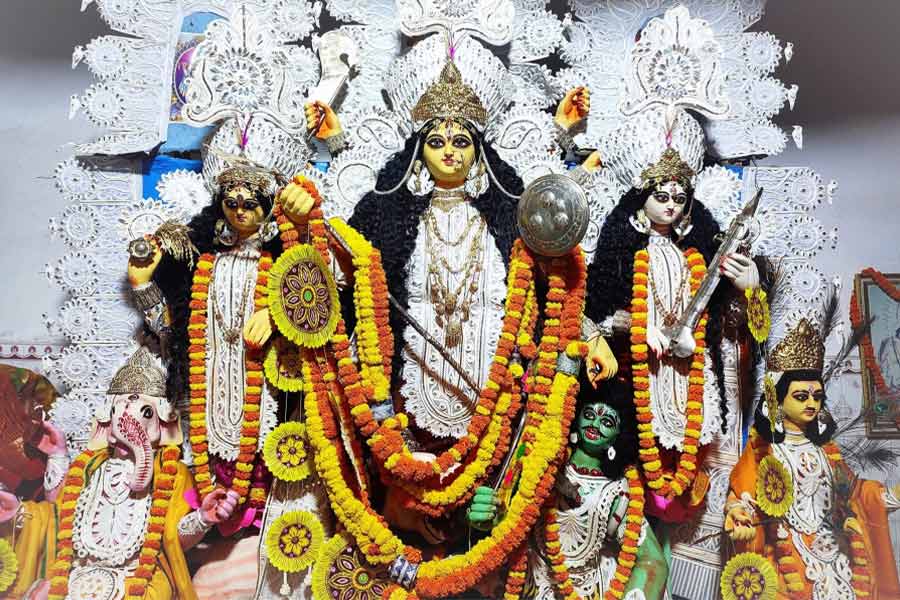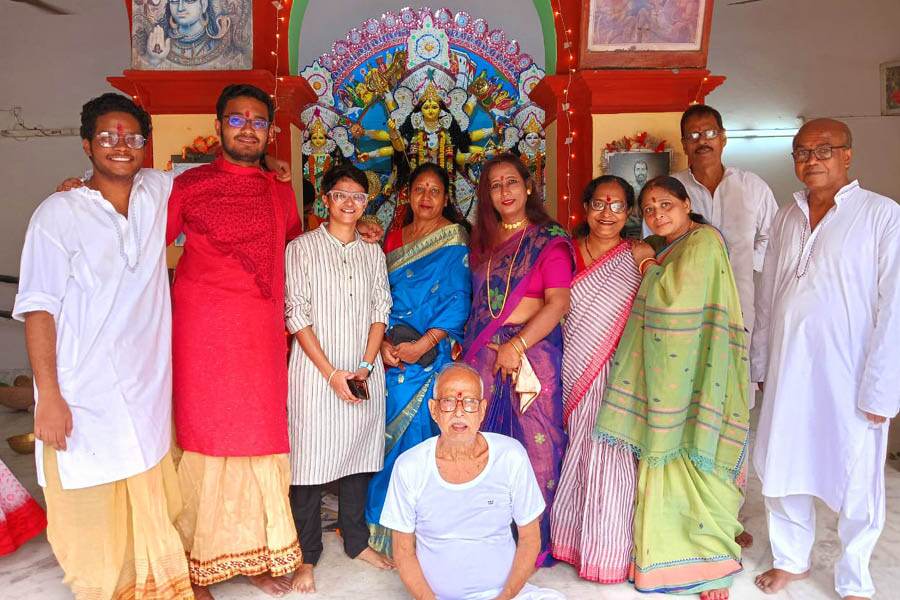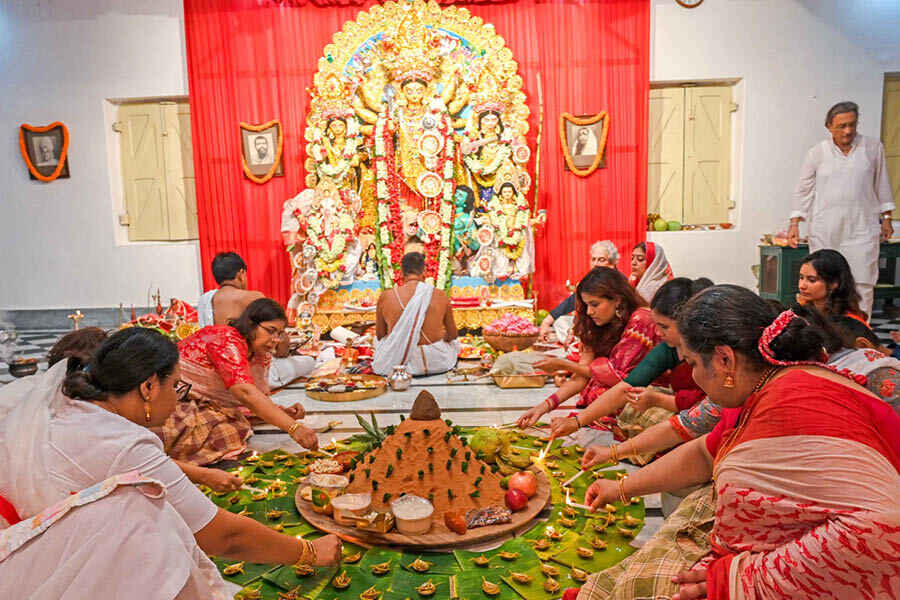It is a pity that the one of the ancient Durga Pujas of West Bengal is not highlighted the way it should have been. The Jagaddhatri Puja at Chandannagar is better known but actually it is rather contemporary compared to the Khalisani Bose Bari Durga Puja of the same town, which is in its 517th year in 2024.
In 1761, Raja Krishnachandra Roy started worshipping Jagaddhatri at Krishnanagar in a grand manner. Subsequently, Jagaddhatri Puja gained more popularity in Chandannagar. However, the Durga Puja of the Basubari at Khalisani in Chandannagar started more than 250 years ago before Krishnachandra’s mega event took place as family members claim.‘
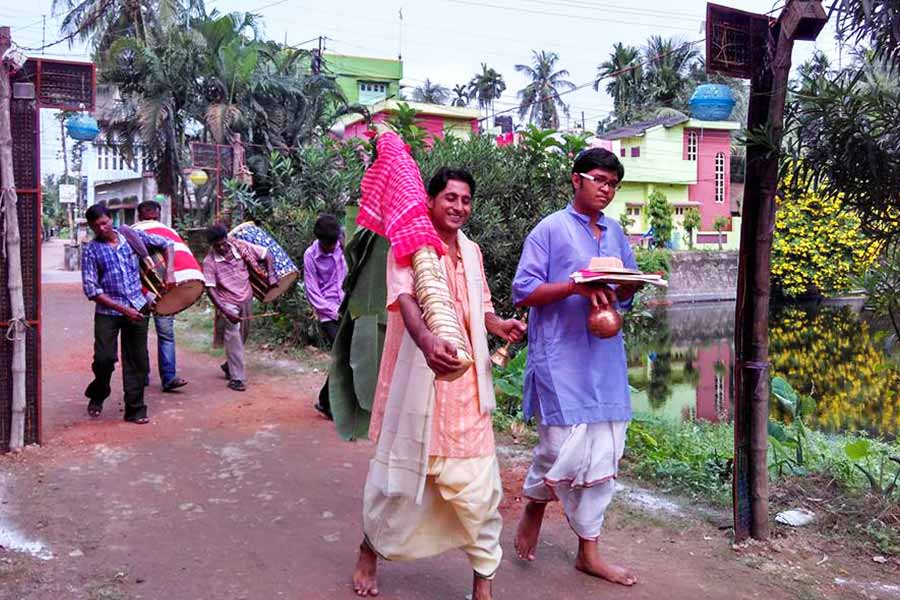
‘Nabapatrika’ rituals of Khalisani Bose Bari takes place on the banks of narrow stream of Saraswati river
It was at the fag end of the 15th century when Karunamoy Bose left his residence at the port town of Tamralipta (today’s Tamluk in Purba Medinipur district) with his family members by boat and reached a village. He wished to settle down there with his family and start a business.
The village was Bilkuli near Chandannagar in Hooghly district on the banks of Saraswati river. Karunamoy expanded his business and eventually built a good rapport with the then Muslim rulers of undivided Bengal (Hussein Shah dynasty). He was entrusted with the village Khalisani where he built up a residential house. He first built a temple for Bishalakshmi, who incidentally is the family deity. After around 10 years, he started celebrating Durga Puja. At that time, Saraswati river was navigable with large boats floating on making it the main lifeline in that region.
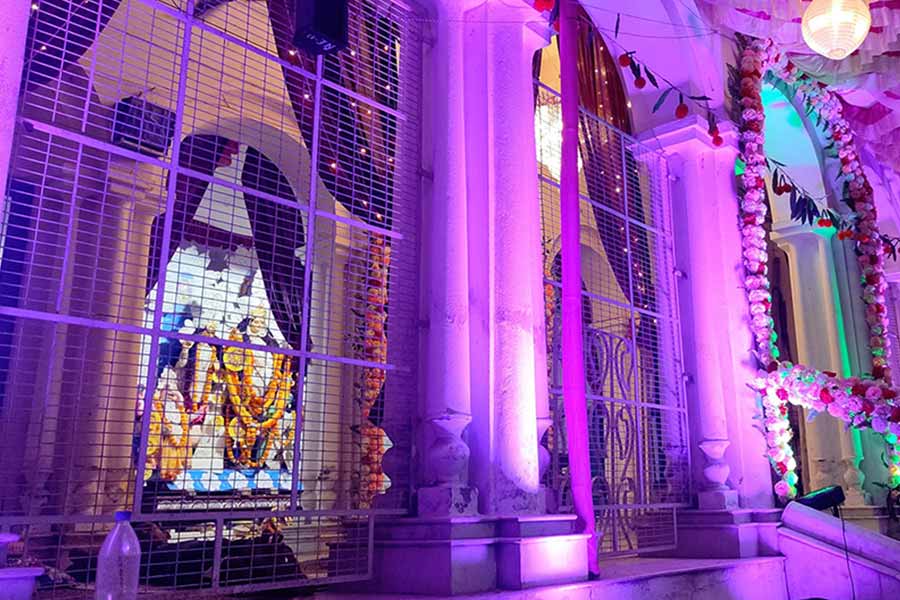
Grand décor of ‘thakur dalan’ of Khalisani Bose Bari in 2023
Karunamoy had four sons. After his death, his eldest son, Debidas, took charge of the puja as the family head. The descendants too continued with the family puja meticulously and in 1702, Sahasraram, great-grandson of Debidas built a huge mansion for residence of his eight sons, which is known as Aatbari. The worship of their family deity and Durga Puja are still being conducted in this Aatbari. There is a separate five-arched thakur dalan (inner courtyard) for worshipping the deities.
Bose Bari of Chandannagar is celebrating its 517th Durga Puja in Bosepara area of Khalisani this year. The Durga dalan has undergone major renovation but the correspondent was informed by senior family members this was the same place where the puja is being conducted since long.
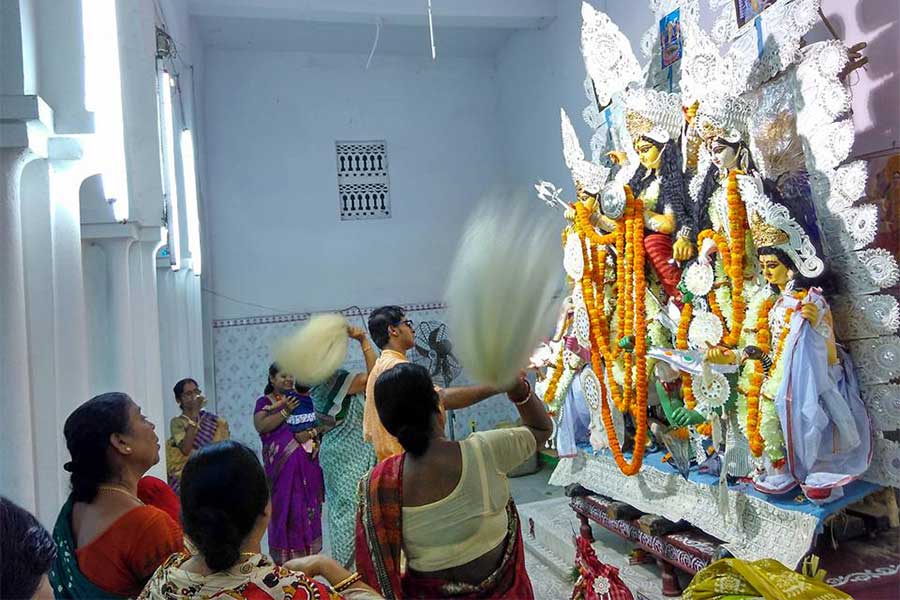
‘Arati’ during the Durga Puja at Khalisani Bose Bari, Chandannagar
The idol of the goddess is prepared in the thakur dalan itself and the deity looks like a real-life goddess when the artisans give the finishing touches. The goddess is decked up in white shining foil (rangta) embellished with silver sequins. The deity is adorned in gold jewellery of which some are age-old and being passed over for generations. A considerable number of weapons of the deities are made of silver. It is said many devotees who visit the goddess for the first time in the thakur dalan are overwhelmed by her aura.
The dhakis, the priest and even the artisans preparing the idol of the deities belong to the same families who having been taking part in the festival for several years. The family of Gokulchandra Pal has been preparing the deities for ages and prepares a Durga idol, which is perhaps as glamorous as the goddess Jagaddhatri of Chandanngar.
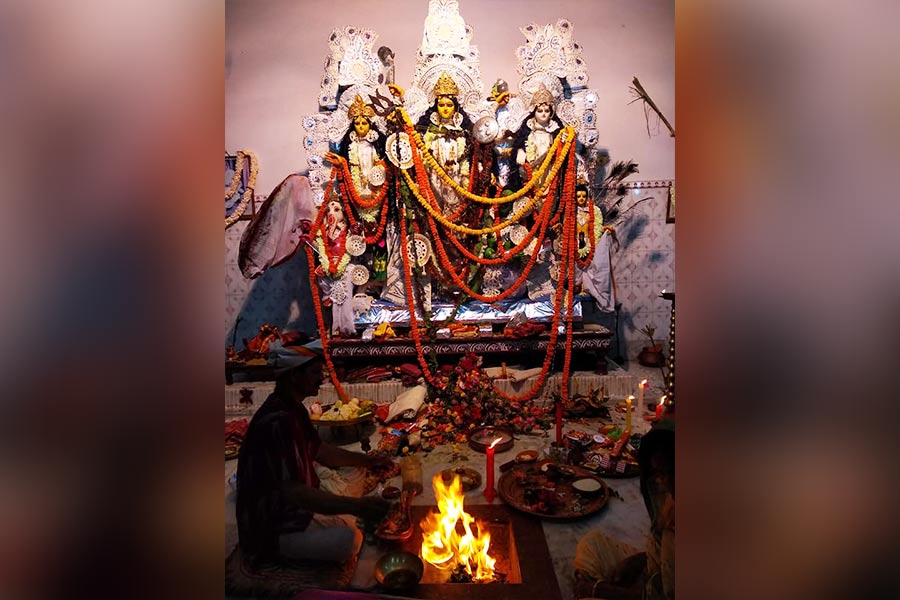
‘Hom yagna’ rituals being performed in front of the goddess
Kathamo Puja of Khalisani Bose Bari Durga Puja used to take place on Janmashtami but for last few years, it has been shifted to the day of Rath Yatra. Bodhon (welcoming the goddess) takes place on Pratipad. There is a separate room for bodhon adjacent to the thakur dalan. From Pratipad, Chandipath is also is conducted in that room on daily basis.
Nabapatrika rituals take place on Saptami morning. Interestingly, the nabapatrika is taken to Saraswati river for conducting its rituals and not to the Hooghly. Since the Bose family came to Chandannagar sailing on Saraswati river, the rituals are conducted there to commemorate that. However, the famed river is just a small stream now. A single prepubescent girl is being offered Kumari Puja on Ashtami.
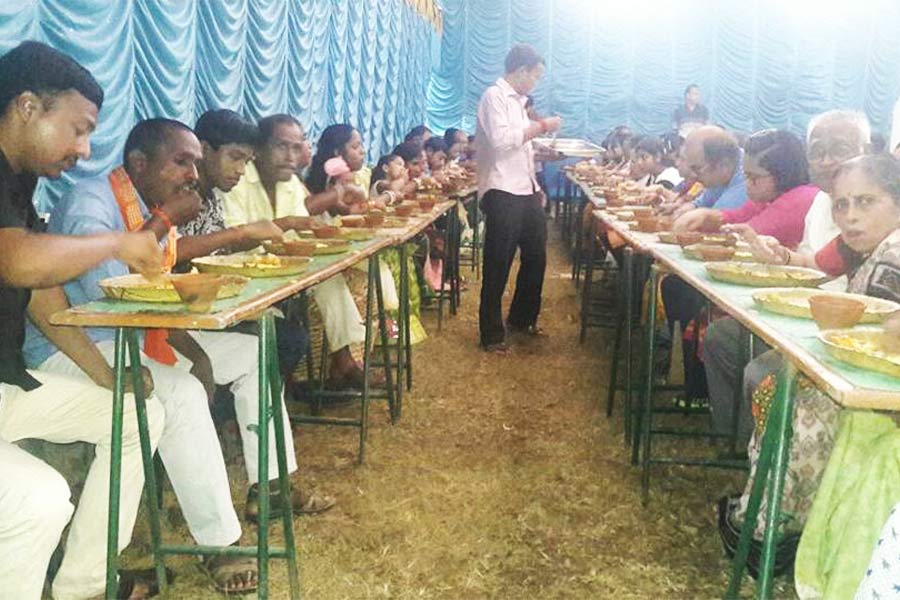
There used to be a grand feast on Nabami at Khalisani Bose Bari, Chandanngar. After Covid, it has been discontinued and devotees are served packed bhog
In the morning, rice naibedya is offered along with several fruits and sweets to the goddess at the Bose residence. In the evening, the deity is offered luchi along with several type of sandesh made of chenna, several kinds of indigenous narus.
The grandest of the offering or bhog takes place on Nabami. It includes khichuri, alu dam, five types of fried vegetables, mixed vegetables, payesh and chutney. Earlier several people were invited and they sat in rows while food was served. Post-Covid the scenario has changed and the devotees are now offered packed bhog.
During Sandhi Puja, all family members in unison light 108 brass lamps placed on a stand.
Dhuno purano (burning of lac) takes place on Nabami, in which several women from the family and neighbourhood participate. Thereafter, nabagraha home yagna takes places for a considerable long time. Usually, home yagna is conducted for one deity. Here, nine celestial planets are worshipped at a time. This is one of the important rituals of the Bose family.

Evening bhog being prepared for the goddess at Khalisani Bose Bari. The women are preparing ‘naru’ in the foreground, while in the background, a gentleman is busy preparing ‘luchi’ on a gas stove
On Dashami, after darpan biswarjan and dadhi karma rituals, the women of the house take part in sindoor khela after boron ritual is over. Later, kankanjali rituals also take place.
Earlier, family members could arrange for immersion of the goddess physically to the river. However, now the deity is carried to the ghat for immersion by a vehicle.
Before immersion, the deity is taken to the temple of family deity Bishalakshmi and a puja is performed there. Earlier, the deity used to be immersed in the Saraswati river, flowing by the temple.
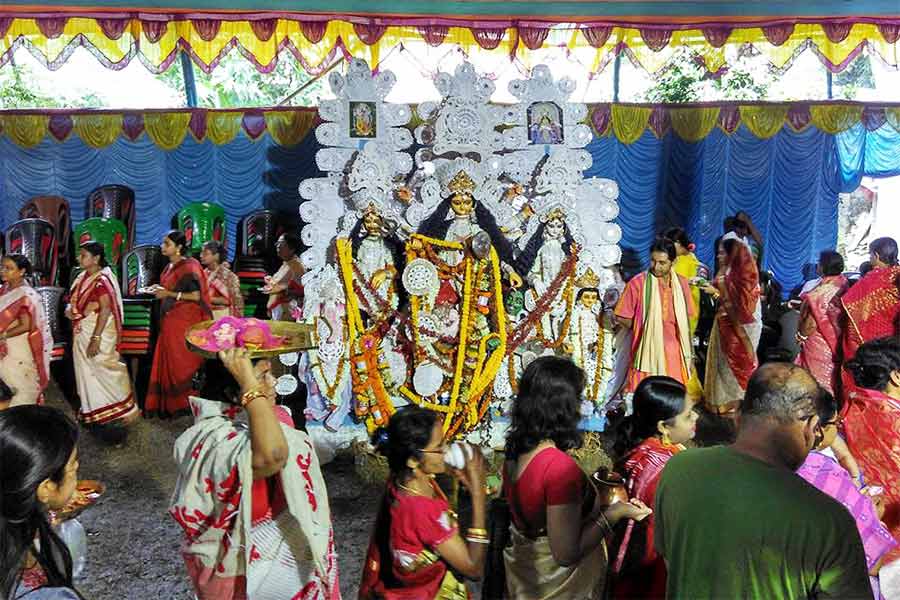
Women conduct ‘thakur baron’ on Dashami at Khalisani Bose Bari, Chandannagar
The main ghot on which the puja of Khalisani Bose Bari of Chandannagar is performed is immersed in the narrow steam of Saraswati and not in the Ganga. Several hundred years have passed, but the Khalisani Bose family of Chandannagar has not forgotten its roots.
